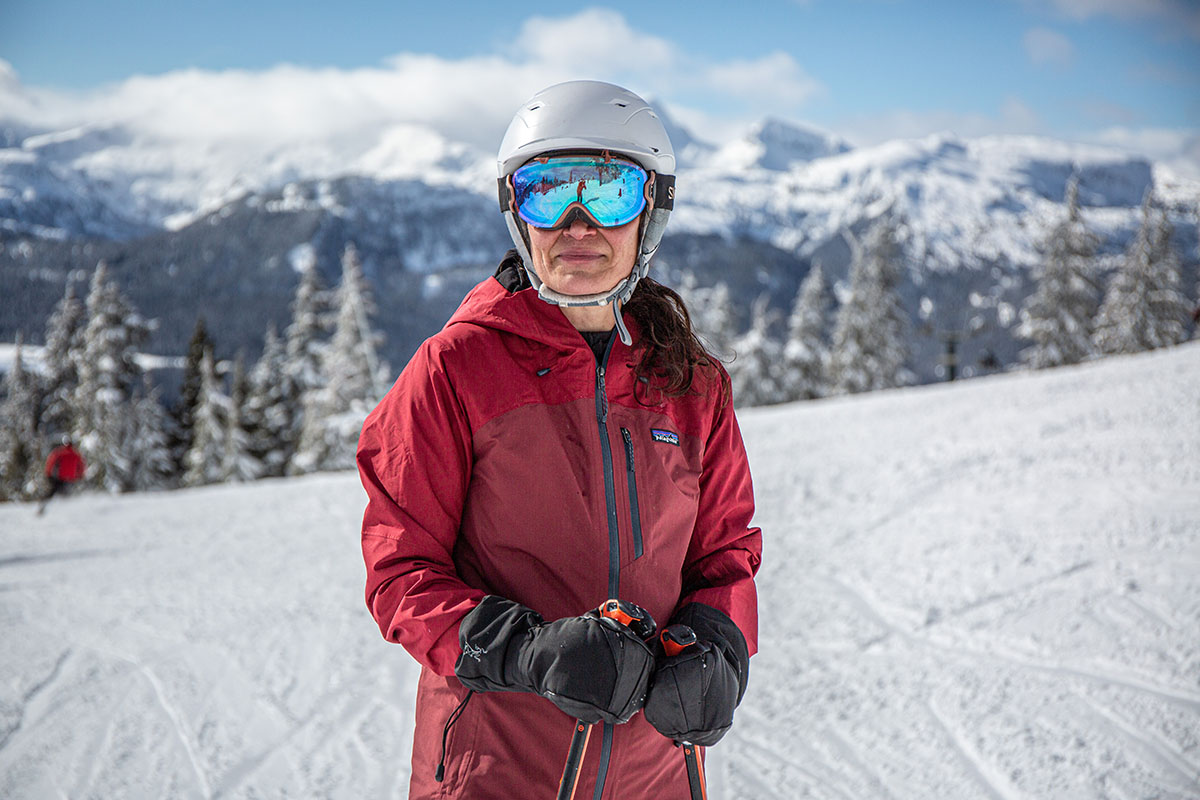
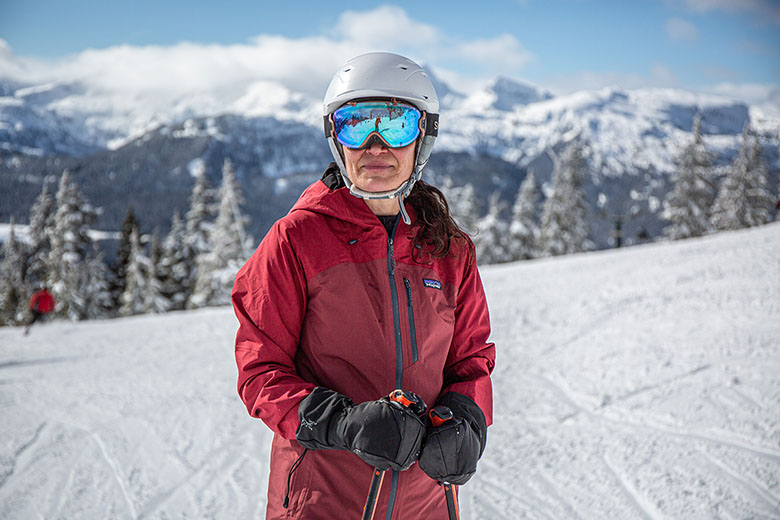
Price: $399
Waterproofing: 2L H2No Performance Standard
Insulation: 80g & 40g Thermogreen
What we like: Everything we look for in a resort jacket—including great warmth, comfort, and durability—at a reasonable price.
What we don't: Too warm and not breathable enough for high-output use or mild conditions.
See the Women's Insulated Powder Town See the Men's Insulated Powder Town
Patagonia’s ski jacket lineup runs the gamut from backcountry-ready hardshells to insulated resort designs. Formerly called the Snowbelle/Snowshot, their Insulated Powder Town falls into the latter category, offering a competitive combination of warmth, comfort, and durability for frequent inbounds use. It’s also a major step up on the sustainability front from its predecessor, including 100% recycled materials and a PFC-free DWR coating. The jacket’s weight and lack of breathability put it squarely in the on-trail resort category, but it’s a very protective and cozy option for inbounds skiing. Below we break down our experience with the women's Insulated Powder Town. To see how it stacks up to the competition, see our articles on the best ski jackets, best women's ski jackets, best snowboard jackets, and best women’s snowboard jackets.
Combining a sturdy 2-layer H2No Performance shell with a DWR (durable water repellent) finish, the Patagonia Insulated Powder Town Jacket is highly effective at sealing out gnarly winter weather. I put the jacket through some serious conditions in Manning Park and on Mount Washington, and it deftly kept out all moisture—no leaks or dampness made their way through the outer layer. The thick shell put up an equally strong defense against brutal winds, sealing out chilly gusts. For added protection, the large hood fits easily over my Smith Vantage MIPS helmet, the hand pockets feature large flaps over the zippers, the powder skirt easily attaches to the matching Insulated Powder Town Pants, and the high collar covers most of my face when I’m slouching on a chairlift. Finally, it’s worth noting that the Powder Town has a longer hemline than the outgoing Snowbelle, which was a boon on cold lifts and when I had to hunker down in a snowbank while my husband fixed one of his bindings.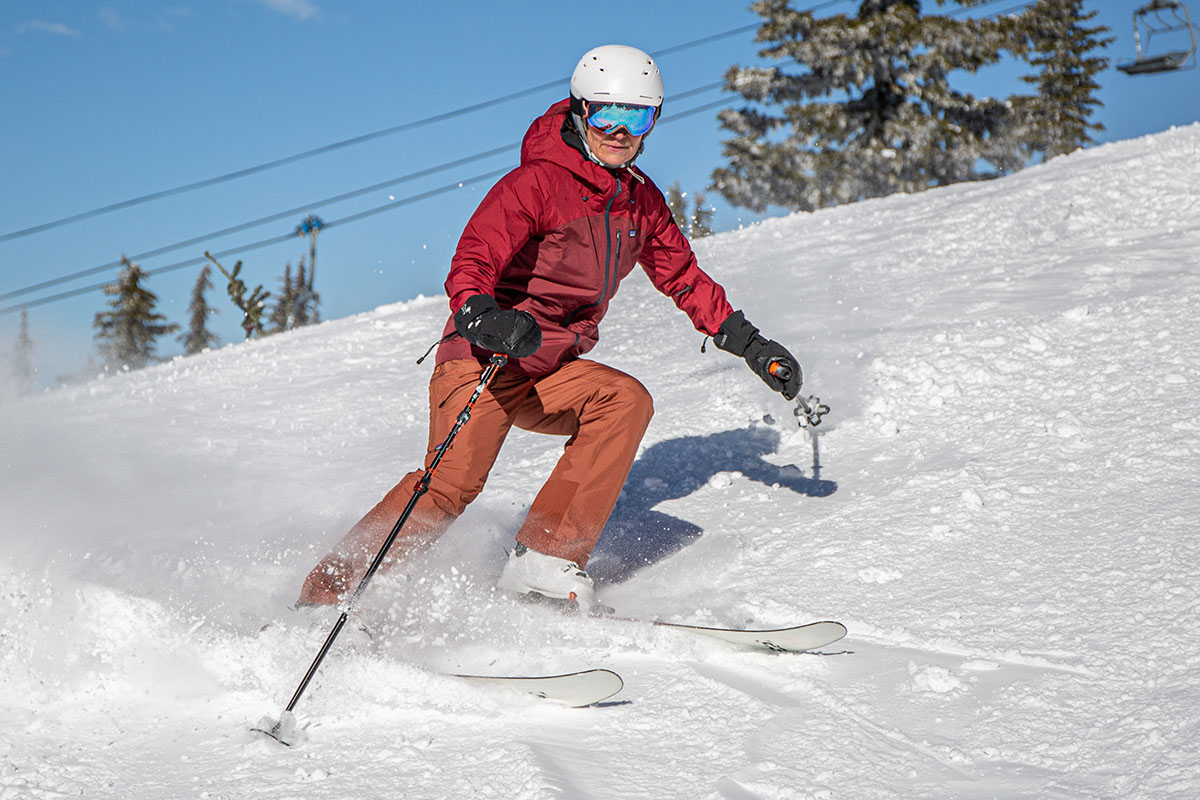
As Patagonia’s entry-level insulated ski jacket, the Powder Town provides a good dose of warmth in moderate winter conditions. Like many other insulated designs, the Powder Town uses more insulation in the body (80g of synthetic Thermogreen) than it does in the sleeves (40g), although I haven’t noticed much of a difference between the two areas. I did experience some draftiness where the insulation ends close to the main zipper while skiing, but it’s minimal and has a negligible impact on overall warmth. I also appreciate that the collar is rigid enough to stay up even with the hood down (the Snowbelle’s wasn’t), and the adjustable cuffs and hem make it easy to seal in heat. I spent a lot of time on cold and blustery chairlifts last season —including a stalled lift in Manning Park—and each time, I was thankful to be wearing the Insulated Powder Town.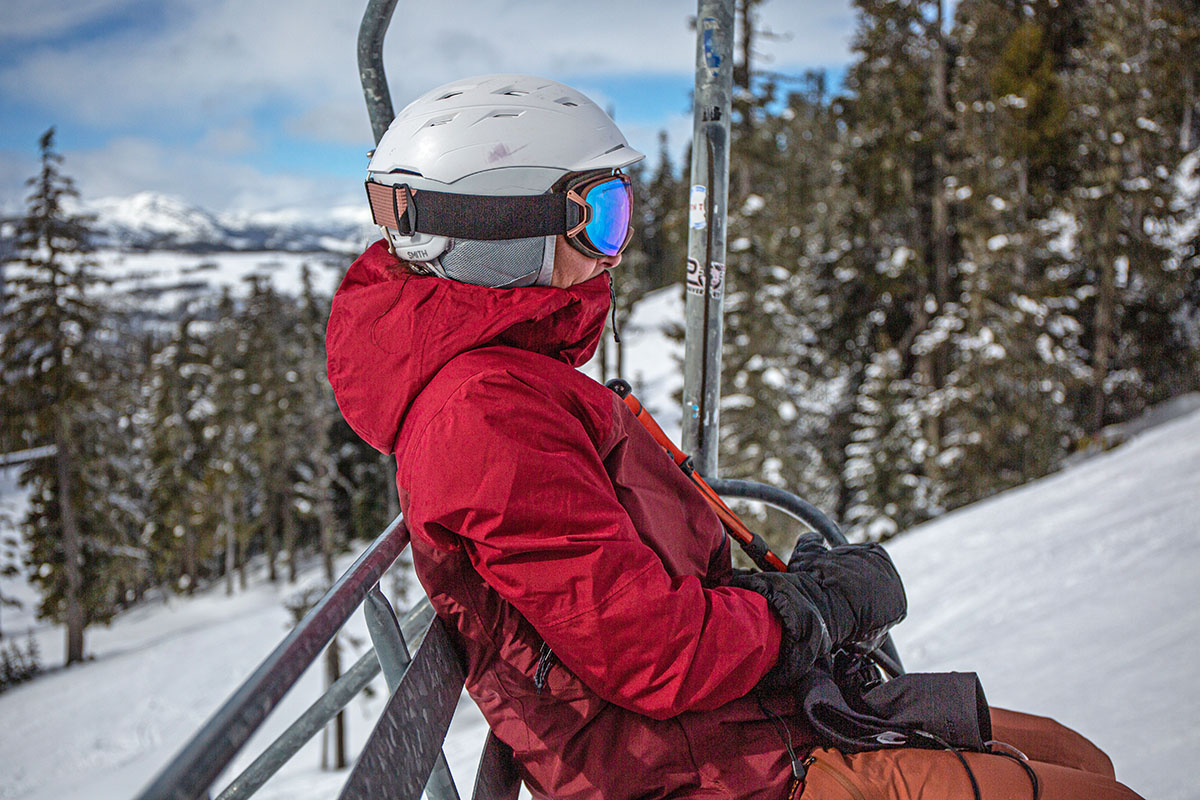
It's important to note that while insulated ski jackets are meant to provide a nice boost in warmth compared to their uninsulated counterparts, they do have their limitations on frigid days. In sum, the Powder Town performs well in near-freezing temperatures at the resort (paired with just a light baselayer) but requires added layers when the mercury drops below that. In my experience, temperatures below the mid-teens Fahrenheit will require either opting for a warmer jacket—my go-tos are the Arc’teryx Beta Insulated Jacket and Patagonia Micro Puff Storm Jacket—or adding a down or synthetic jacket underneath. If you go the latter route, I recommend sizing appropriately so that you can adequately layer depending on the conditions (thankfully, the fit is generous enough to work with various layering systems).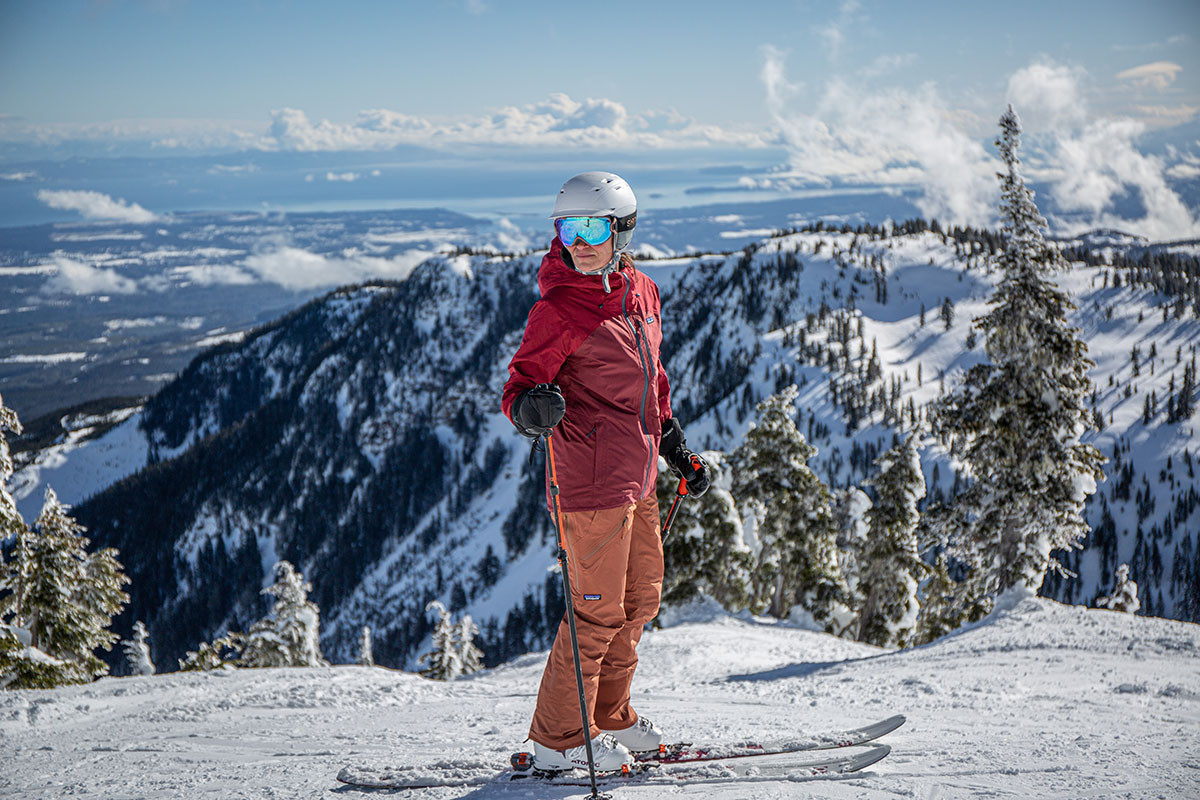
The Patagonia Insulated Powder Town is designed with resort skiing in mind, and therefore breathability isn’t nearly as big of a concern as it is with more backcountry-focused jackets. As expected, the thick insulation makes the jacket run warm when on the move. But the Powder Town does come with pit zips to dump heat quickly, which came in particularly handy when my husband’s binding broke on Mount Washington. After taking a chairlift midway down the mountain, we had to hike up a run to the lodge to complete the fix. Although temperatures were in the upper teens Fahrenheit, I heated up quickly from the effort. Thankfully, the pit zips helped cool me down, and once we began skiing again, I experienced no dampness or clamminess. To be sure, I wouldn’t bring the Powder Town into the backcountry or on any adventure where extensive hiking is required (the uninsulated Powder Town would be better for sidecountry trips), but the jacket’s pit zips offer enough ventilation for most resort days.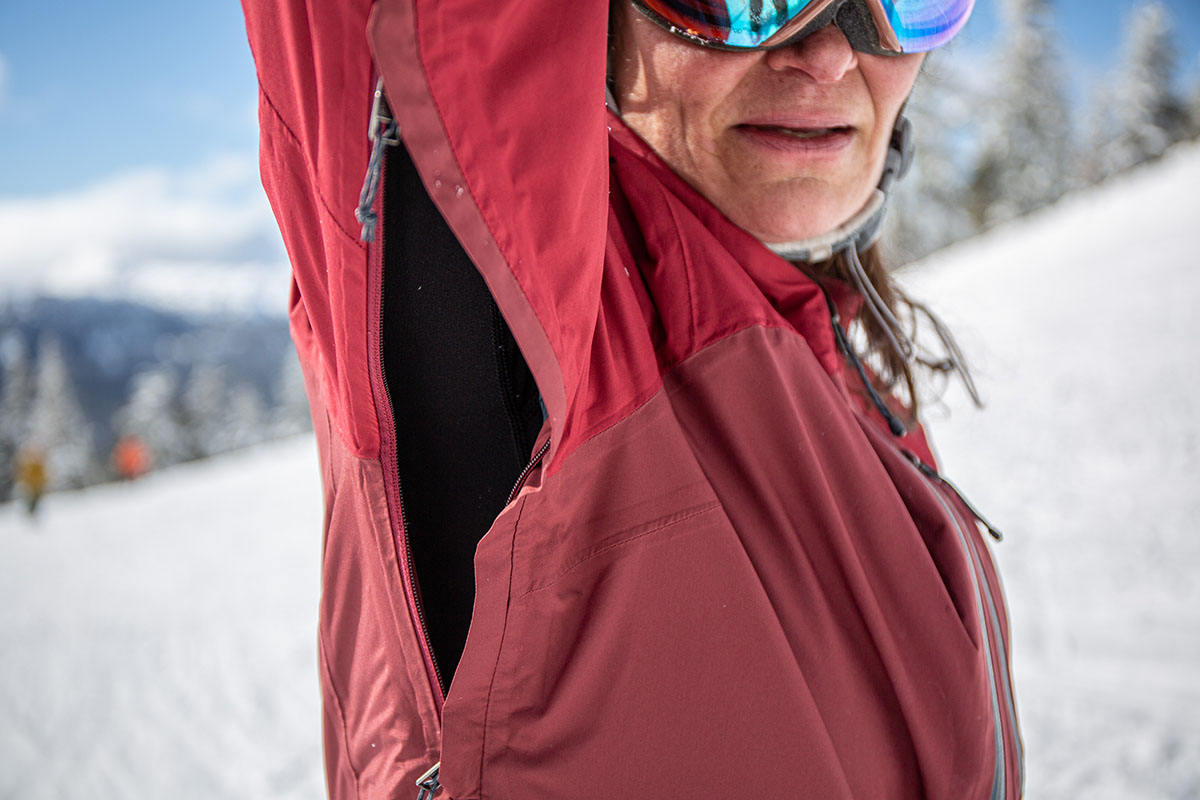
Like the since-discontinued Snowbelle, the Patagonia Insulated Powder Town scores high marks in the comfort department. First and foremost, the polyester taffeta lining is extremely smooth and supple and slides easily over baselayers. There’s also a cozy fleece lining along the collar and hand pockets. I do wish the former were a little thicker—as it is, the zipper pokes out and causes slight irritation along my jawline—and Patagonia did away with the additional fleece panel along the back of the neck that you got with the Snowbelle. But the rest of the design is as comfortable as ever: The shell fabric is soft and quiet, and the fit is non-restrictive regardless of which layers I choose. Truthfully, I barely notice the Powder Town when I’m wearing it, which is just what you hope out of a ski jacket and a testament to Patagonia’s top-notch build quality.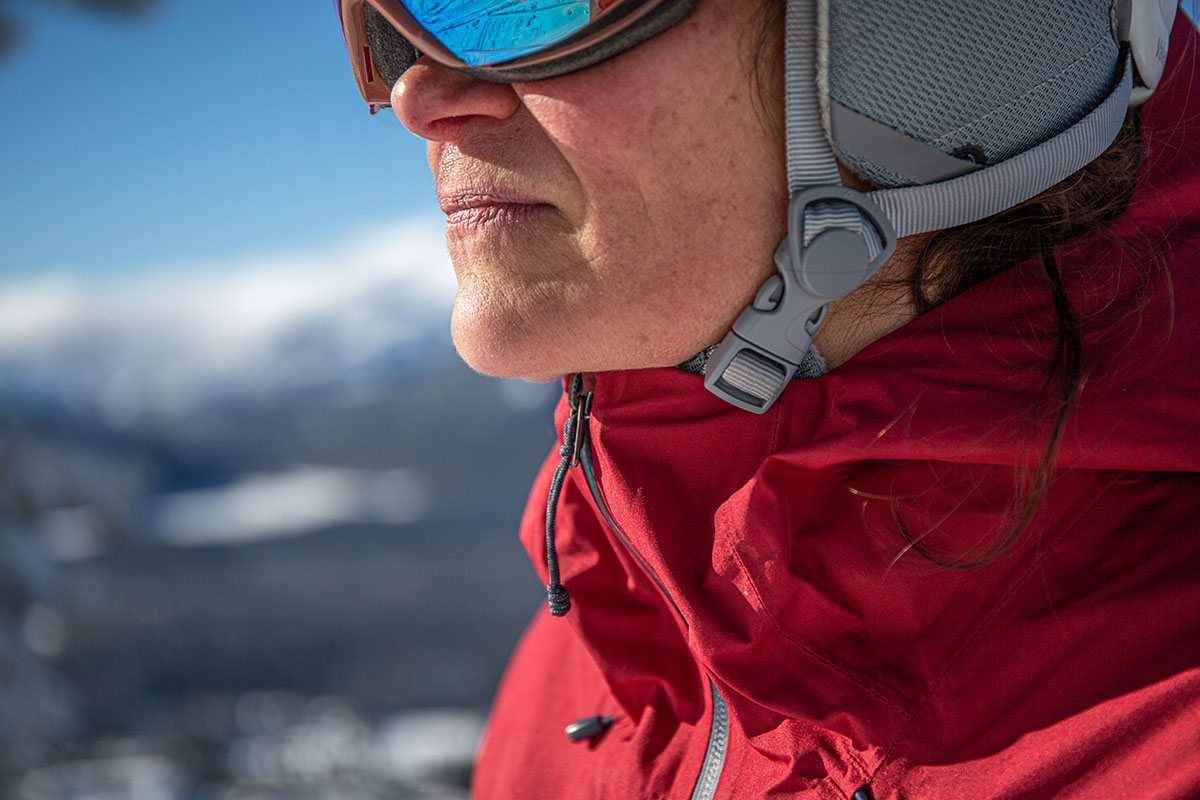
Patagonia gear rarely disappoints from a build quality standpoint, and the Insulated Powder Town is no exception. The jacket’s outer shell is a reasonably robust 75-denier (D) polyester, which lines up well with other premium resort designs and has held up well to testing with little wear to show for it. It’s worth noting that Patagonia’s own Storm Shift Jacket is even burlier with a 150D shell, but the Powder Town is plenty durable for most resort-goers. And the rest of the design is equally well executed, from the smooth zippers to the clean seams, Velcro cuffs, and quality hem and hood drawcords. Given my positive impressions thus far—plus my experience with the past-generation (and similarly built) Snowbelle—I expect the Powder Town to have a long lifespan.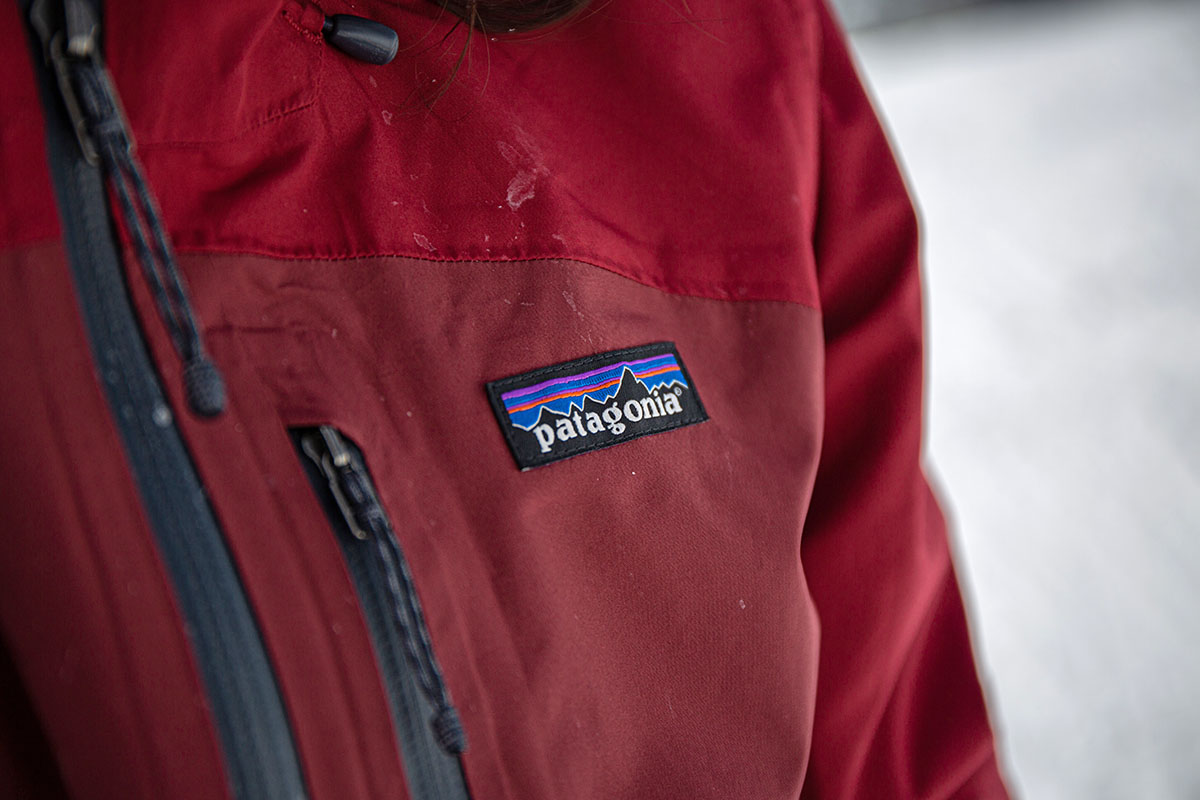
At 1 pound 10 ounces for my women's size small (just 0.9 oz. under its listed weight), the Insulated Powder Town is a decidedly resort-focused jacket. Here, weight matters much less than it does in the backcountry, where ounces add up quickly as you haul gear up thousands of vertical feet. And compared to other insulated resort shells, the Snowbell is fairly average. Similar designs like the Flylow Gear Sarah (1 lb. 11.1 oz.) and REI Co-op Powderbound (1 lb. 9 oz.) clock in at similar weights, while 3-in-1 jackets come in noticeably heavier, including the 3-in-1 version of the Powder Town (2 lb. 3.9 oz.). If weight is a concern, you can save a lot with an uninsulated hardshell like Arc’teryx’s Sentinel Jacket (1 lb. 4.8 oz.) or Flylow Gear’s Lucy Jacket (1 lb. 3.5 oz.). But for resort days, I was never overly concerned with the Powder Town’s packed size (which is expectedly large), nor did it feel heavy or excessively bulky on the slopes.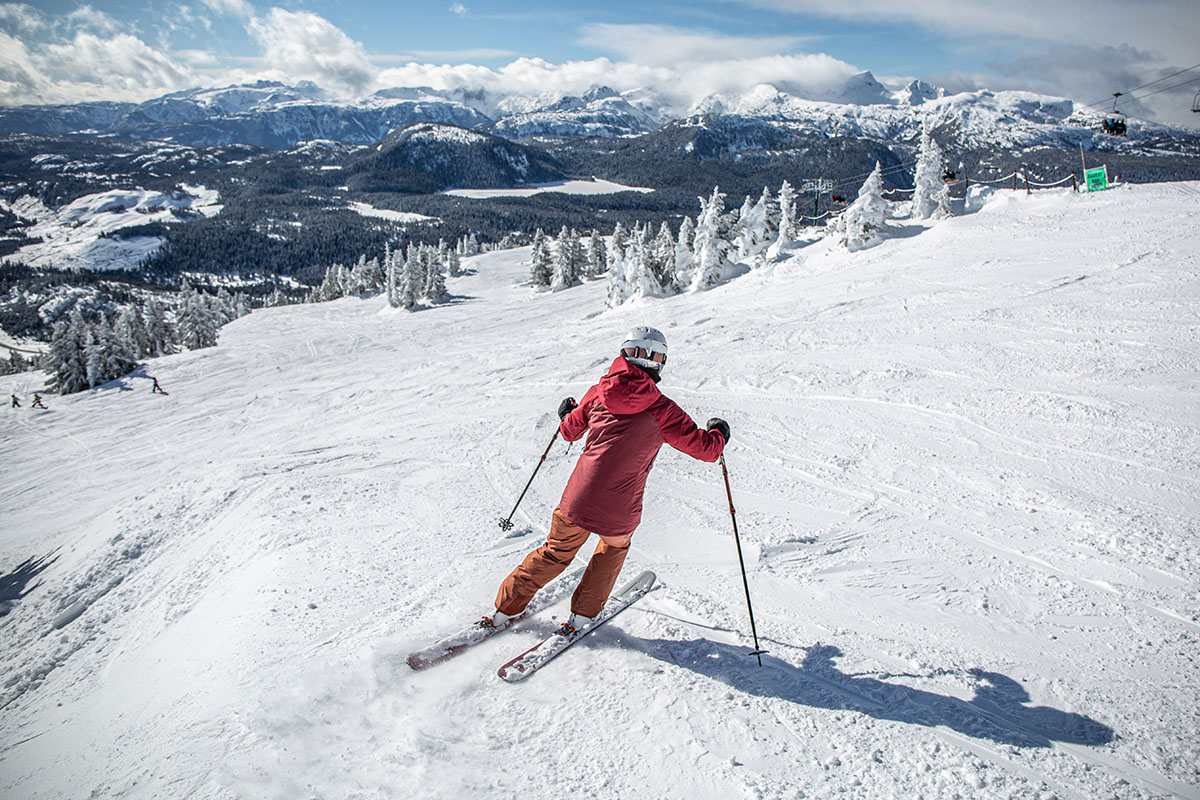
Overall, I was very happy with the Powder Town’s protective and full-coverage hood. To adjust, you simply pull the two drawcords at the base of the neck and one at the back of the head—it’s easy to snug both over a ski helmet. I do wish the collar toggles were a little larger to operate with gloved hands more easily, but it’s not a deal breaker by any means. The hood also has a low-profile, laminated visor that holds its shape well. I still prefer Arc’teryx’s StormHood design found on many of their premium ski shells, but the Powder Town’s hood isn’t far off and checks all the boxes for resort use.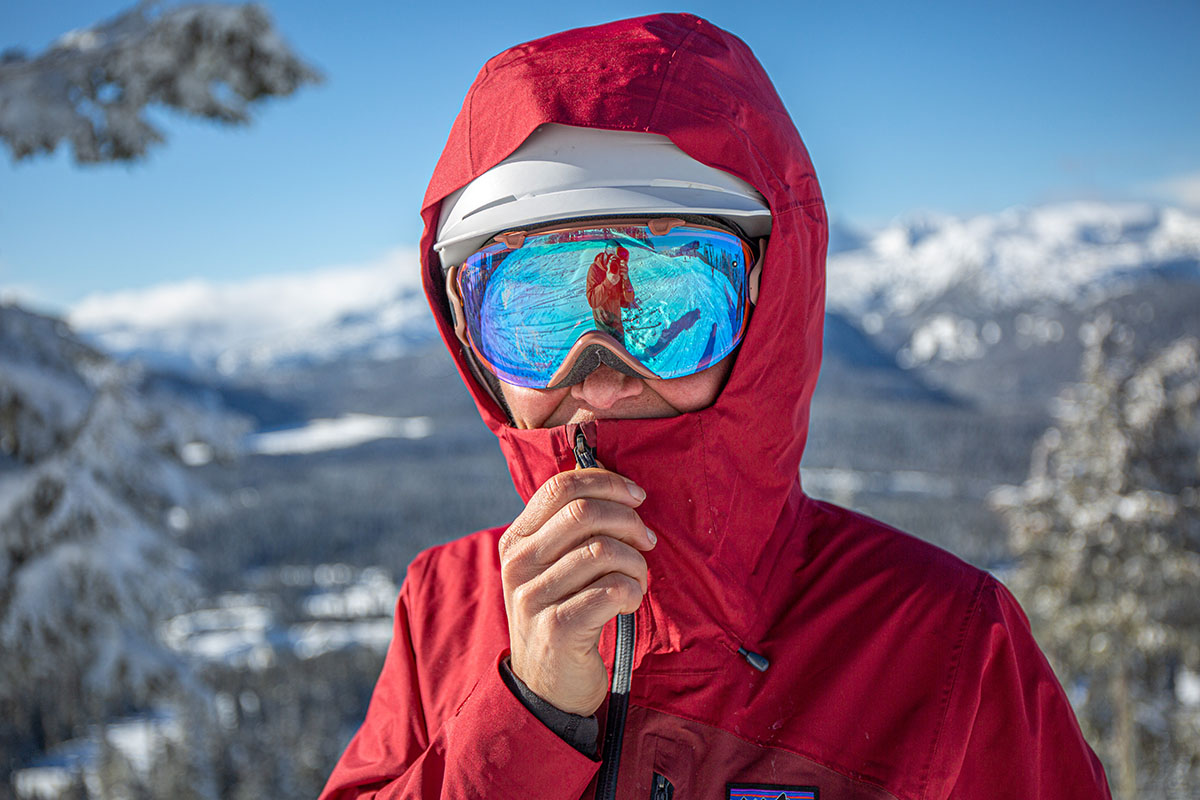
With a total of six pockets, the Patagonia Insulated Powder Town has plenty of places to stow the essentials. The two fleece-lined handwarmer pockets are generously sized and contain pull cords to adjust the hem, while the single exterior chest pocket is phone-friendly and features cable routing for listening to music. Unlike the Snowbelle, the Powder Town also boasts a ski pass pocket on the left forearm, which was a welcome addition and is well placed for quick scanning. On the inside, you get an internal zippered stash pocket on one side and a dump pocket on the other. The latter is great for storing ski gloves and a beanie, although its positioning right above the powder skirt is limiting for bulkier items.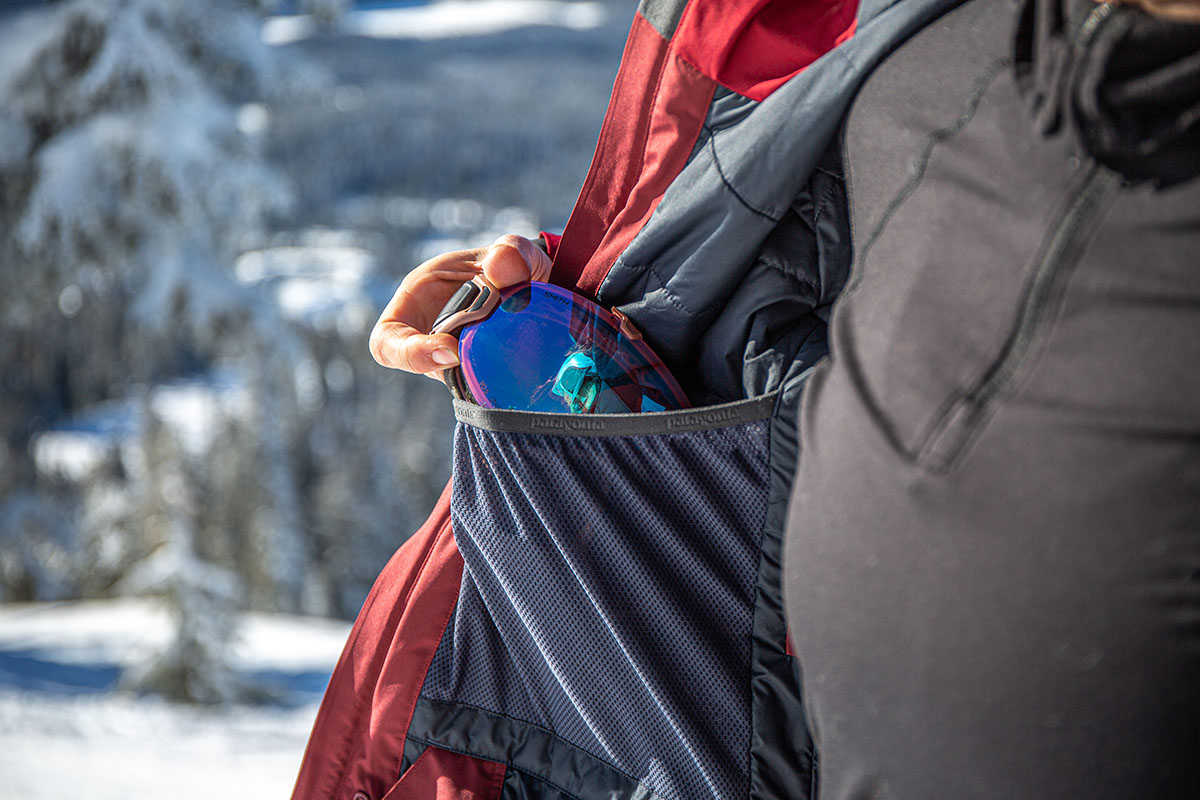
I usually wear a women's extra small in Patagonia gear, but I opted for a small in the Insulated Powder Town so that I had some wiggle room for layering underneath. Overall, I found the “regular” fit to be spot-on: The jacket never felt (or looked) too roomy or loose, no matter which layers I paired underneath. For reference, my go-to midlayer last season was the ultralight (and since-discontinued) Arc’teryx Cerium SV, which fit comfortably under the shell with no restriction or impact on mobility. Additionally, the sleeves are an ideal length and articulated for mobility, the Velcro cuffs can adjusted to fit under or over gloves, and the center back length (3o in. a women's small) is great for my 5'8" frame—it covers my butt when sitting on cold chairlifts without any uncomfortable bunching. 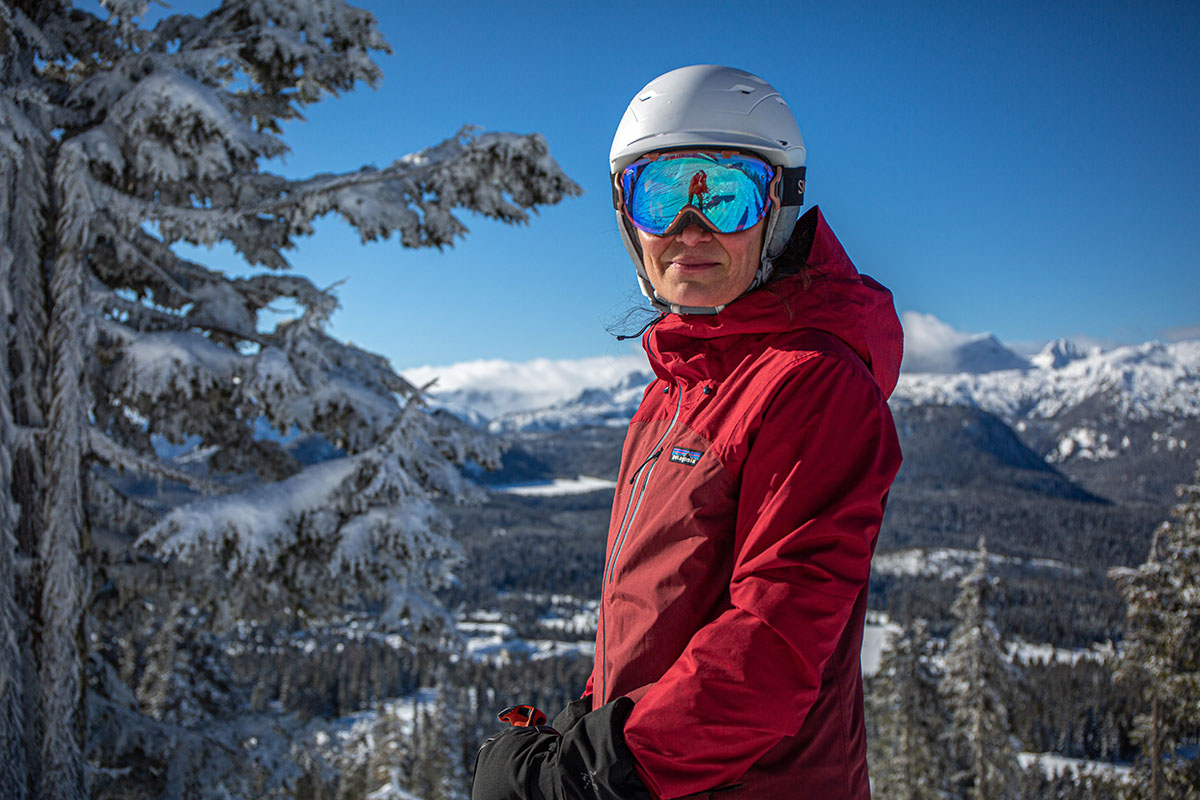
Patagonia is well known for their focus on sustainability, and the Insulated Powder Town Jacket represented a significant jump from the outgoing Snowbelle. For starters, the shell, lining, and insulation are all 100% recycled. Patagonia also tacked on a PFC-free DWR finish, which forgoes the use of harmful perfluorocarbons. Further, the jacket’s lining is bluesign-approved, meaning it’s been certified as safe for workers, the environment, and consumers. And finally, the Powder Town is Fair Trade Certified sewn, which indicates that Patagonia put extra money into production to ensure that workers have safe working conditions, adequate pay, and access to programs like healthcare and childcare services. Added up, the Powder Town is now a sustainability leader in the ski jacket market.
The Powder Town lineup runs the gamut from the insulated jacket reviewed here to snow pants, bibs, uninsulated shells, and 3-in-1 options for men and women. To complete your kit, the Insulated Powder Town Pants ($269) boast the same 2-layer H2No Performance fabric as the jacket and ample mobility for skiing inbounds terrain. If you prefer a 3-in-1 design, the 3-in-1 Powder Town Jacket ($499) is a nice alternative to the insulated model: It uses the same waterproof membrane and similar design features but adds in a zip-out 60-gram synthetic jacket. Rounding out the lineup are three uninsulated pieces: the standard Powder Town Jacket ($349), Powder Town Pants ($249), and Powder Town Bibs ($299), all which are largely similar to the options mentioned above but without the added warmth of synthetic fill. All styles are available in both men’s and women’s versions, and the uninsulated pieces (jacket, pants, and bibs) come in kids’ models, too.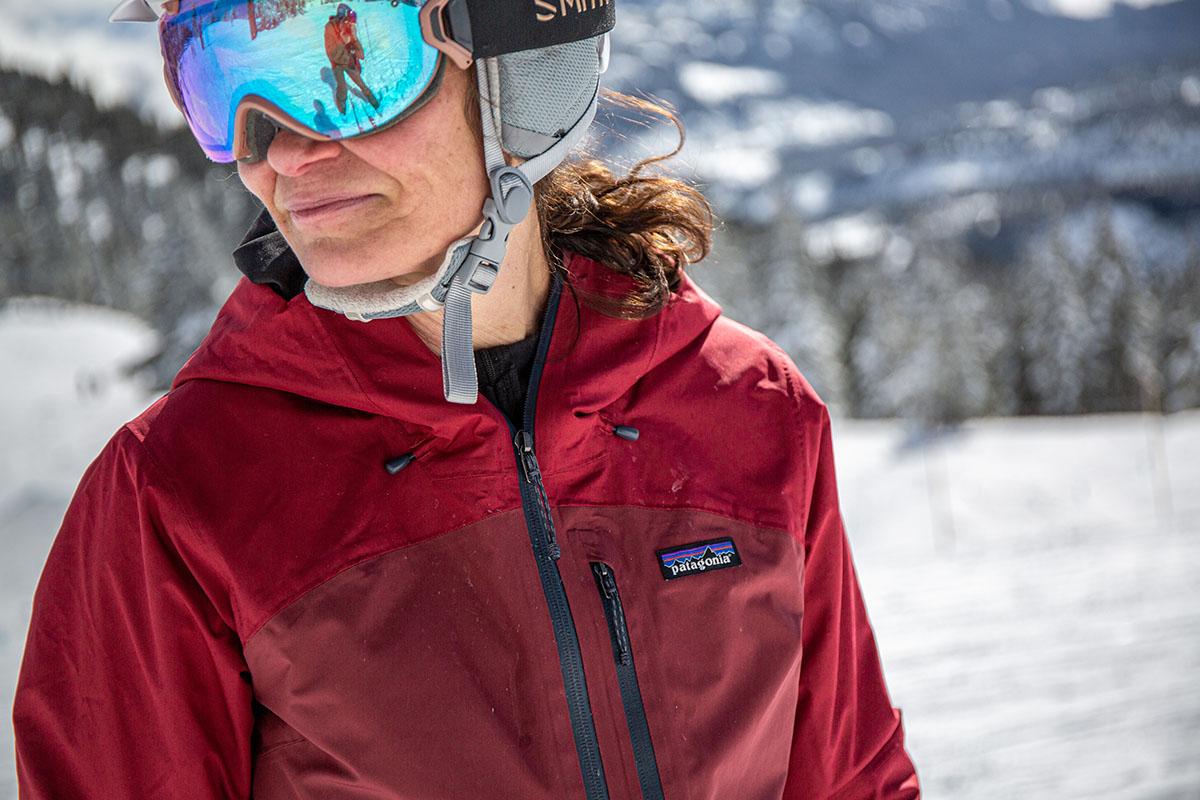
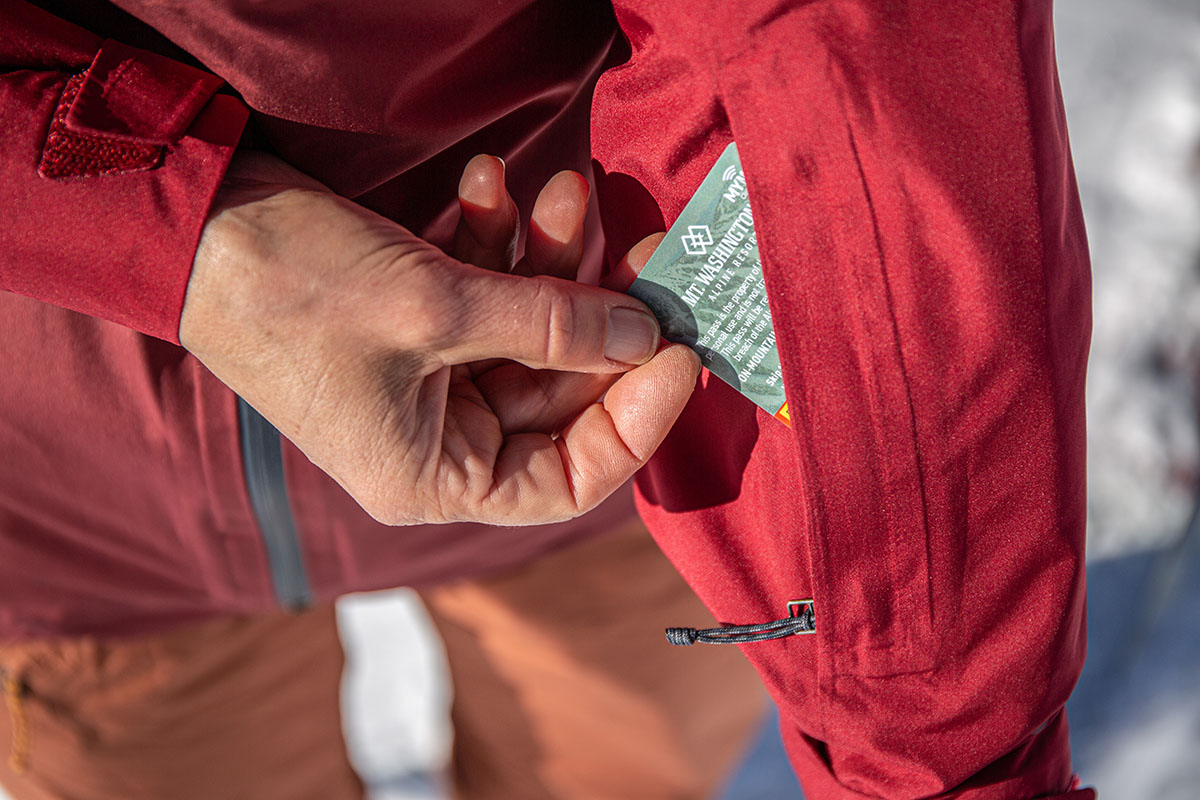
| Jacket | Price | Type | Best For | Waterproof | Insulation | Weight |
|---|---|---|---|---|---|---|
| Patagonia Powder Town | $399 | Insulated | Resort | 2L H2No | 80g / 40g | 1 lb. 10.9 oz. |
| Patagonia Storm Shift | $499 | Shell | Resort | 2L Gore-Tex | Fleece | 1 lb. 9.5 oz. |
| Helly Hansen Alphelia LifaLoft | $550 | Insulated | Resort | 2L Helly Tech | Synthetic | 2 lb. 3.3 oz. |
| Flylow Gear Sarah Jacket | $300 | Insulated | Resort | 2L Finish | 80g | 1 lb. 11 oz. |
| Outdoor Research Tungsten II | $479 | Insulated | Resort | 2L Gore-Tex | 60g / 45g | 1 lb. 12.9 oz. |
| REI Co-op Powderbound | $199 | Insulated | Resort | 2L Peak | 80g / 60g | 1 lb. 8.9 oz. |
From uninsulated hardshells to 3-in-1 options, there’s no shortage of resort-ready ski jackets to consider. Within Patagonia’s lineup, the Storm Shift Jacket offers a step up in overall performance, including a more premium 2-layer Gore-Tex construction and a thicker (150D) shell that’s well suited for frequent inbounds use. It’s not insulated like the Powder Town, although you do get a soft fleece liner for great next-to-skin comfort, and many skiers will appreciate the ability to tailor warmth depending on conditions (it's far more comfortable on a sidecountry hike). In the end, a final decision will come down to preferences on warmth, protection, and price: The Storm Shift is the better match for truly rough and rowdy conditions, but the Powder Town will save you $100 and makes sense for resort-goers who run cold.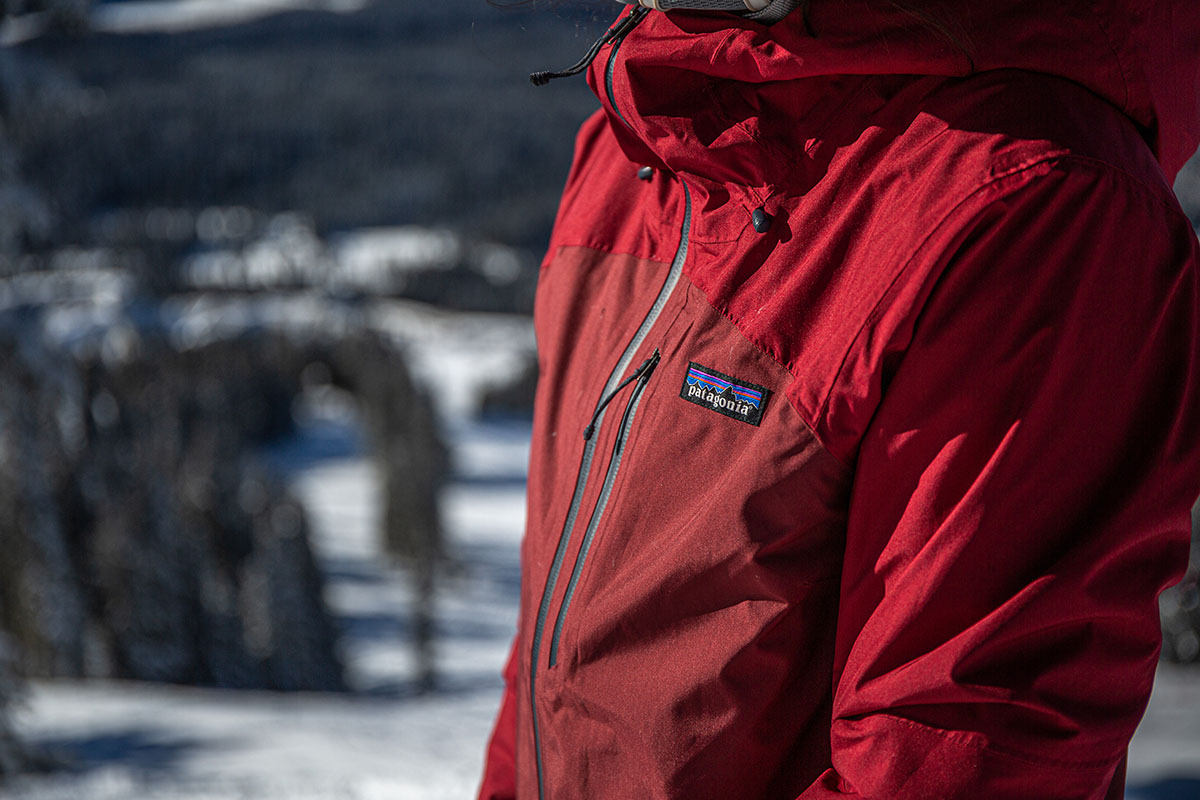
Another premium but strong alternative is Helly Hansen’s Alphelia LifaLoft. Like the Powder Town, the Alphelia is insulated (it uses LifaLoft synthetic) and boasts a full suite of resort-ready features, including a powder skirt (the Alphelia’s is detachable), helmet-compatible hood (also removable), ample storage, and a Recco reflector. We also love the addition of four-way stretch, which boosts range of movement and comfort. Weight jumps to a hefty 2 pounds 3.3 ounces, and you do pay a steep premium at $550, but the Alphelia puts it all together better than most (the Powder Town included) and is our favorite insulated resort design this year.
Flylow Gear is another leader in the ski jacket market, and their competitor to the Powder Town is the Sarah Jacket. For $99 less than the Patagonia, the Sarah offers similar warmth with 80-gram synthetic insulation; sports a functional feature set including a powder skirt, helmet-compatible hood, waterproof zippers, and hand gaiters; and has a stretchier shell that increases overall mobility. You do compromise a little in wet-weather protection with Flylow’s 2-layer Finish build that's more prone to absorbing moisture, but the Sarah nevertheless is a capable resort design for less than the Powder Town.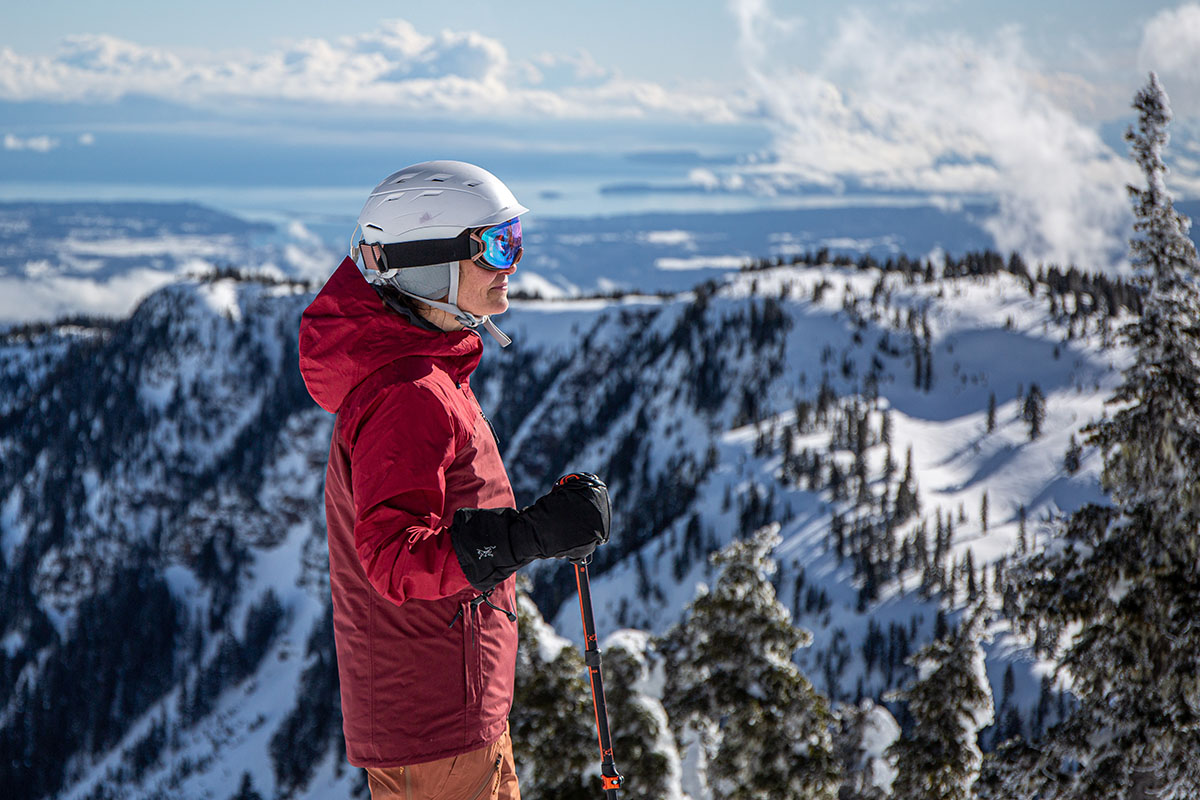
Outdoor Research offers another competitive resort design in their Tungsten II Jacket. Rather than in-house waterproofing, OR opted for a more premium and protective 2-layer Gore-Tex build, which we found to be a great match for areas that see a lot of snow and wind. The OR doesn’t skimp on features, either: You get pit zips, a powder skirt, a functional and helmet-friendly hood, five total pockets, and plenty of adjustability. However, the Tungsten is a bit heavier, and we found the prior generation ran noticeably warm even with the zippers open for venting (the latest design boasts a largely identical construction to its predecessor). In the end, both are capable and well-built resort designs, but we don’t feel the OR is worth the extra $80 over the Patagonia.
Last but not least is REI Co-op’s budget-friendly Powderbound Insulated Jacket. For only $199, the Powderbound features functional touches including a helmet-compatible hood, high collar, pit zips, and a powder skirt. You also get a good dose of warmth with 80-gram synthetic insulation around the core and 60-gram in the sleeves. The biggest sacrifices you make are in protection and looks: The REI’s 2-layer nylon shell isn’t as proven and weather-ready as Patagonia’s higher-end H2No build, and the Powderbound has a decidedly casual look—plus a larger and boxier fit. To be sure, the REI is a fine option for occasional resort-goers who don’t demand a lot of performance from their shell, but it’s a clear step down from the Powder Town in overall quality.
If you’re thinking about buying gear that we’ve reviewed on Switchback Travel, you can help support us in the process. Just click on any of the seller links above, and if you make a purchase, we receive a small percentage of the transaction. The cost of the product is the same to you but this helps us continue to test and write about outdoor gear. Thanks and we appreciate your support!
Depending on the seller, most products ship free in the United States on orders of $50 or more. International shipping availability and rates vary by seller. The pricing information on this page is updated hourly but we are not responsible for inaccuracies.